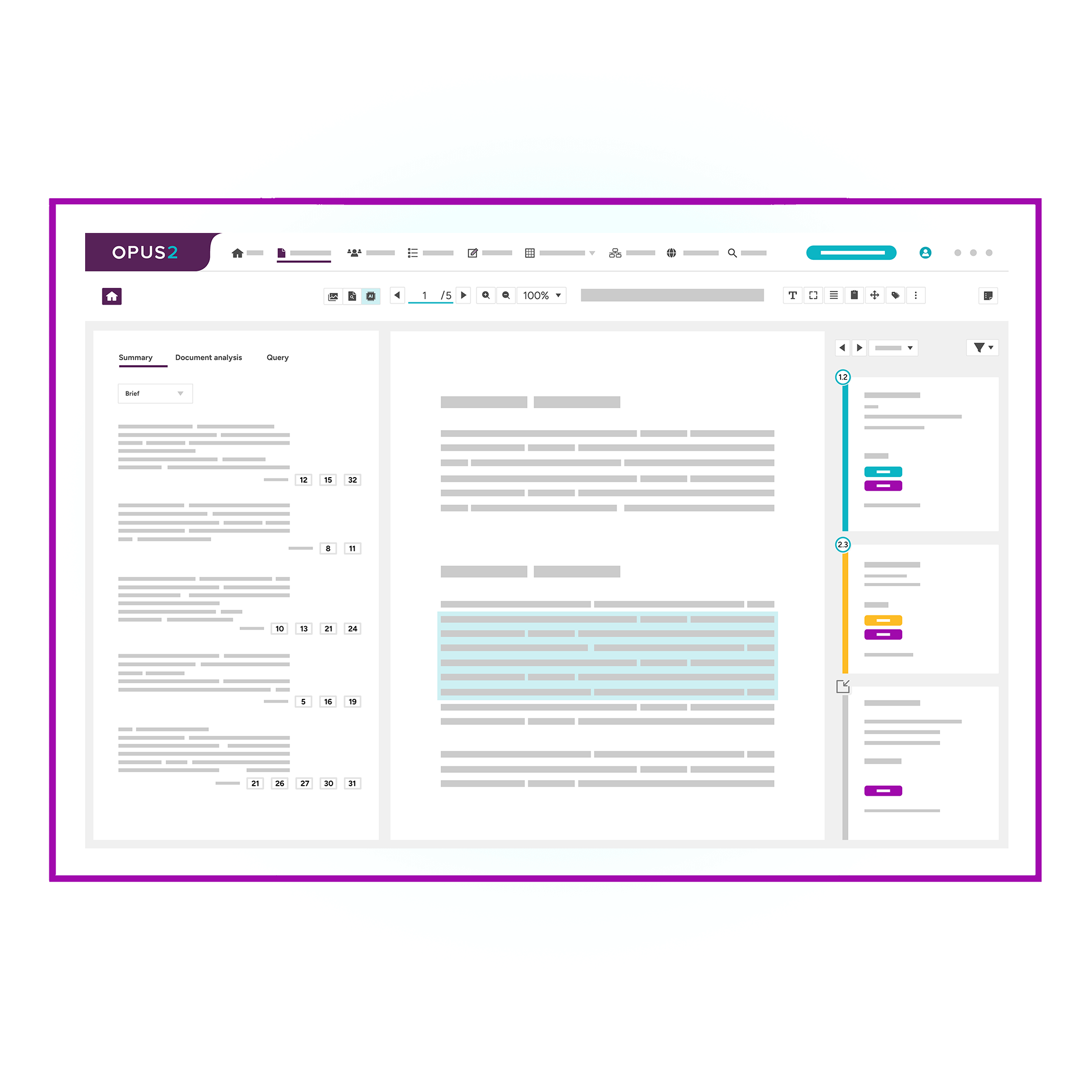
Opus 2: Complete Buyer's Guide
Comprehensive case management platform with integrated AI capabilities
Opus 2 is a comprehensive case management platform that integrates AI capabilities directly into legal workflows, targeting mid-to-large law firms seeking to consolidate document analysis and case preparation tools. Rather than offering standalone AI solutions, Opus 2 embeds artificial intelligence features within its broader legal technology ecosystem, providing context-aware queries, multiple summary formats, and centralized collaboration capabilities[25][33].
Market Position & Maturity
Market Standing
Opus 2 occupies a distinctive market position as a comprehensive platform provider with integrated AI capabilities, competing within the established legal technology ecosystem rather than the emerging AI-specific vendor landscape[25][33].
Company Maturity
Organizational maturity indicators suggest an established vendor with comprehensive support capabilities and implementation expertise. Available evidence indicates positive customer satisfaction with the vendor's support services, particularly regarding responsiveness and technical expertise during complex implementations[33].
Longevity Assessment
Stability assessment benefits from the vendor's comprehensive platform approach, which typically provides more sustainable business models than specialized point solutions. However, specific financial metrics, funding status, or growth indicators are not available in the research materials, requiring direct vendor inquiry for detailed stability evaluation[33].
Proof of Capabilities
Customer Evidence
Implementation evidence demonstrates Opus 2's capabilities through documented customer success patterns, though specific customer names and quantified outcomes require additional verification. Available research indicates positive satisfaction among firms that successfully integrate Opus 2 into existing workflows, with customers particularly valuing the platform's comprehensive approach and integration capabilities for complex cases requiring extensive document management[33].
Case Study Analysis
Deployment validation shows successful implementations typically involve phased deployment strategies, beginning with smaller cases to build organizational confidence before scaling to larger matters[33].
Market Validation
Market validation appears through the vendor's positioning strategy and customer adoption patterns, though specific adoption metrics or customer growth indicators are not documented in available research[33].
Competitive Wins
Competitive validation emerges through the platform's differentiated approach compared to specialized AI vendors. While tools like DepoIQ focus specifically on deposition analysis[4] and SmartDepo emphasizes GPT-4 integration[6], Opus 2's comprehensive case management integration provides workflow advantages that reduce the need for multiple disparate tools[25][33].
AI Technology
Opus 2's technical foundation centers on integrated AI capabilities embedded within a comprehensive case management platform rather than standalone artificial intelligence tools. The system employs context-aware document analysis that maintains strict boundaries around case-specific materials, preventing AI responses from drawing on irrelevant or external information sources[25].
Architecture
The platform's architecture emphasizes integration over specialized AI functionality, designed to reduce tool proliferation while enhancing workflow efficiency across legal teams[25][33].
Primary Competitors
Primary competitive landscape positions Opus 2 against comprehensive platform providers rather than specialized AI vendors, with the company competing within established legal technology ecosystems rather than emerging AI-specific markets[25][33].
Competitive Advantages
Competitive advantages center on integrated platform approach that reduces tool proliferation and workflow fragmentation compared to standalone AI solutions[25][33]. The platform's context-aware AI capabilities represent meaningful differentiation from generic AI applications that lack legal-specific training and boundary controls[25].
Market Positioning
Market differentiation emerges through platform integration strategy designed to embed AI capabilities within existing legal workflows rather than requiring separate tool adoption[25][33].
Win/Loss Scenarios
Win/loss scenarios favor Opus 2 in situations where comprehensive platform integration provides greater value than specialized AI capabilities, particularly for established firms with complex case management requirements and resources for sophisticated implementations[33].
Key Features

Pros & Cons
Use Cases
Featured In Articles
Comprehensive analysis of AI Deposition Summarization for Legal/Law Firm AI Tools for Legal/Law Firm AI Tools professionals. Expert evaluation of features, pricing, and implementation.
How We Researched This Guide
About This Guide: This comprehensive analysis is based on extensive competitive intelligence and real-world implementation data from leading AI vendors. StayModern updates this guide quarterly to reflect market developments and vendor performance changes.
37+ verified sources per analysis including official documentation, customer reviews, analyst reports, and industry publications.
- • Vendor documentation & whitepapers
- • Customer testimonials & case studies
- • Third-party analyst assessments
- • Industry benchmarking reports
Standardized assessment framework across 8 key dimensions for objective comparison.
- • Technology capabilities & architecture
- • Market position & customer evidence
- • Implementation experience & support
- • Pricing value & competitive position
Research is refreshed every 90 days to capture market changes and new vendor capabilities.
- • New product releases & features
- • Market positioning changes
- • Customer feedback integration
- • Competitive landscape shifts
Every claim is source-linked with direct citations to original materials for verification.
- • Clickable citation links
- • Original source attribution
- • Date stamps for currency
- • Quality score validation
Analysis follows systematic research protocols with consistent evaluation frameworks.
- • Standardized assessment criteria
- • Multi-source verification process
- • Consistent evaluation methodology
- • Quality assurance protocols
Buyer-focused analysis with transparent methodology and factual accuracy commitment.
- • Objective comparative analysis
- • Transparent research methodology
- • Factual accuracy commitment
- • Continuous quality improvement
Quality Commitment: If you find any inaccuracies in our analysis on this page, please contact us at research@staymodern.ai. We're committed to maintaining the highest standards of research integrity and will investigate and correct any issues promptly.